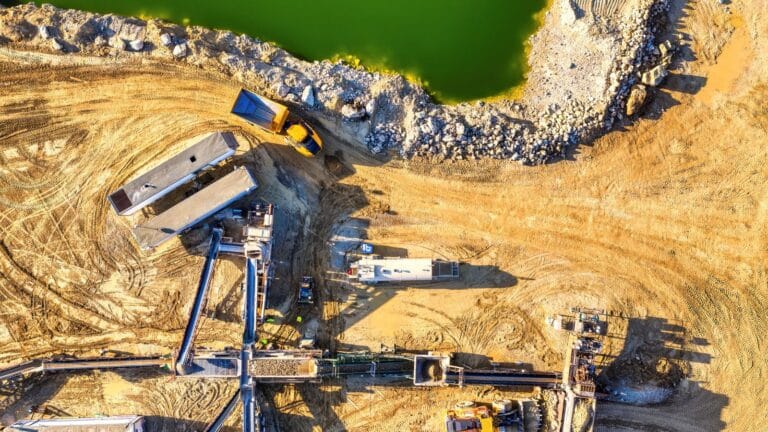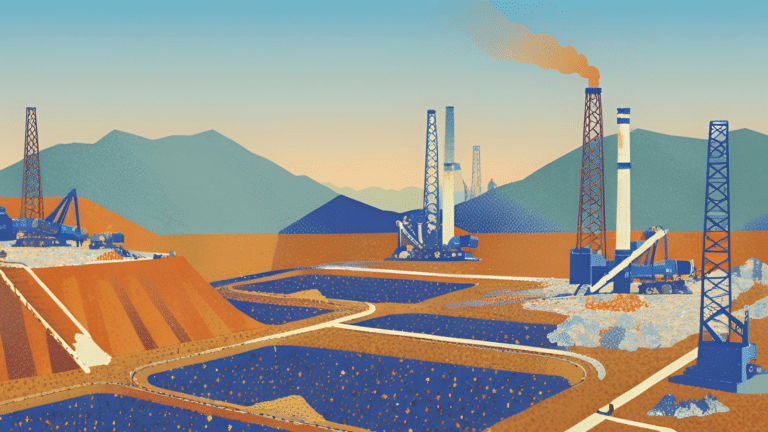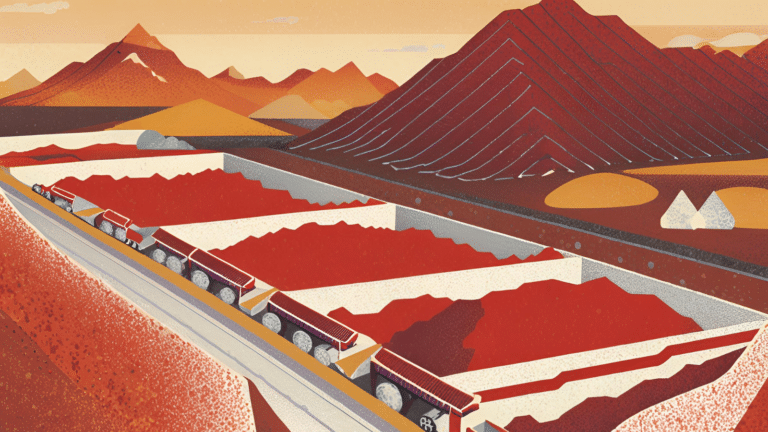This commentary represents the research and views of the author. It does not necessarily represent the views of the Center on Global Energy Policy. The piece may be subject to further revision. Contributions to SIPA for the benefit of CGEP are general use gifts, which gives the Center discretion in how it allocates these funds. More information is available at Our Partners. Rare cases of sponsored projects are clearly indicated.
Automakers must source critical minerals from the United States or free trade agreement (FTA) countries to qualify for the Inflation Reduction Act’s $7,500 tax credit for electric vehicles. While the tax credit is likely to be significantly altered, or eliminated altogether, under the Trump administration, the history of the tax credit sheds light on potential supply chain vulnerabilities for the US and ways to address them through critical minerals agreements. And ultimately, it would not be in the interest of US automakers, aside from Tesla, to abolish the 30D tax credit, since abolishment would make it more difficult for automakers such as Ford, GM, and Stellantis to build global competitiveness in the EV transition.
The United States has FTAs with 20 countries, including key battery supply chain countries like Chile and South Korea. However, several countries in the battery supply chain do not have FTAs with the United States. Japan, a key ally, does not, and its exports would, as a result, not comply with the content requirements in the Inflation Reduction Act (IRA). To remedy this, the United States and Japan quickly signed a free trade agreement limited to critical minerals in March 2023. The critical minerals agreement (CMA) was born.[i] While it finds it origins in the IRA, the conduct of issue-specific trade agreements can help US supply chain resilience under a Trump administration as well.
This type of agreement was heralded by some as sensible[ii] because it takes into account the reality of global supply chain challenges. Others questioned whether this action was consistent with the intent of the IRA.[iii] If the goal is to incentivize downstream (e.g., battery and EV) competitiveness of US firms, then having more resilient and secure global supply chains is clearly important. With or without the 30D subsidy, this objective is also of relevance for the Trump administration to make US automotive companies again globally competitive throughout the EV transition, ideally with some form of reward for more responsibly mined minerals, as this would favor Western mining companies over Chinese projects that often have lower ESG standards.
Indonesia, a leading producer of nickel and cobalt, is another key country in the battery supply chain without an FTA. Following the Japan agreement, Indonesia proposed a similar critical minerals agreement.[iv] Former Indonesian President Joko Widodo, known as Jokowi, reiterated this desire to Vice President Kamala Harris[v] and then to President Joe Biden at the White House.[vi] The two countries have not signed an agreement, but reports suggest consultations continue.
If eventually concluded, the agreement would likely have to be very different from the Japanese agreement. Indonesia is a major producer of raw critical minerals, while Japan is not. The agreement would therefore need to include strong labor and environmental standards, as they are relevant to nickel and cobalt production. The potential agreement has already drawn criticism from a bipartisan group of senators[vii] and leading environmental and labor NGOs.[viii] Domestic and allied nickel producers will also likely criticize any agreement that allows trade in nickel without accompanying level-playing-field measures in terms of environmental and social standards.
But despite these challenges, an agreement could be mutually beneficial and a geopolitical success for the United States, since Indonesia’s critical minerals sector is currently heavily influenced by Chinese companies.
This commentary addresses the importance of Indonesian nickel supply to US climate goals, and why a US-Indonesia critical minerals agreement could be beneficial for both countries. However, such a CMA would hinge on mechanisms that can address the many environmental and labor challenges associated with most Indonesian nickel mining and processing. Integrating such standards in issue-specific critical minerals trade agreements can go a long way to increasing the resilience of US supply chains, lowering US reliance on China, and protecting domestic build out of critical minerals projects.
The commentary discusses options that currently exist in trade agreements, and highlights that these are rather weak and likely insufficient to truly incentivize responsible mining, unless they are redesigned. One notable exception is an environmental rapid response mechanism, which could give the US leverage on how the CMA would apply to mines with different standards.
The focus of this commentary is environmental issues and does not specify labor issues, solely because labor issues are not the area of expertise of the author, not because they are any less important. In fact, several prominent officials who will feature in the next Trump administration have supported provisions on traceability and against forced labor.[ix] Moreover, clear models of what strong labor provisions can look like already exist in trade agreements such as the United States-Mexico-Canada Agreement (USMCA) of 2020.[x] This commentary presents an analysis of half of the challenge, the environmental one, but the other half, labor standards, will need to be included in any adequate CMA as well.
Why Indonesia and the United States Could Benefit from a CMA
Indonesia banned the export of raw nickel ore in 2020 with the goal of localizing the value-added segments of the battery supply chain. Investment soon picked up. An estimated $30 billion in Chinese investment has flowed into nickel projects, especially in high pressure acid leaching (HPAL) facilities.[xi] While HPAL has significant environmental impacts (see below), the technology allows for the extraction of battery grade nickel and cobalt from low grade nickel laterite ores found in Indonesia. Indonesia is now the largest nickel producer in the world, producing 55% of global nickel in 2023, up from only 16% in 2017. And its market share could continue to grow. Indonesia’s significant supply of low-cost nickel is putting downward pressure on the metal’s price, forcing higher-cost nickel projects in Australia to halt production as demand wavers.[xii]
Additionally, Indonesia is projected to become the second largest producer of cobalt this year, behind the Democratic Republic of the Congo (DRC).[xiii] The United States does not have an FTA with the DRC.
Nickel and cobalt are needed for “nickel-rich” lithium-ion batteries such as nickel-manganese-cobalt (NMC) batteries. Compared to lithium-iron-phosphate (LFP) batteries, which do not contain nickel, nickel-based batteries have higher energy density, which equates to a longer driving range per charge. American automakers, including Tesla, have used nickel-based batteries for several of their vehicles.[xiv] Ford invested in an Indonesian nickel project in 2023.[xv] Nickel-based batteries are more expensive than LFP batteries, but the downward pressure on nickel prices from Indonesian supply has improved their cost competitiveness with NMC batteries. For US original equipment manufacturers (OEMs) that produce their highest value models based on NMC batteries, this is a welcome trend that strengthens their margins and allows them to build an EV manufacturing base to compete globally.
Conversely, investors and companies producing cleaner sources of nickel are likely to oppose a US-Indonesia agreement, as they would not be able to compete with HPAL nickel. However, Benchmark Mineral Intelligence stated that without Indonesian nickel “the US currently does not have enough supply coming from its free trade partners to make up for its demand.”[xvi] The company finds that incentivizing nickel production and processing at home and with existing FTA partners will not lead to sufficient supply to cover demand from battery and EV producers.
Access to nickel and cobalt is also important because the US has less access to LFP batteries. More than 90% of LFP cathode manufacturing capacity is located in China, which also has the strongest LFP technological know-how.[xvii]
Geopolitics is a major impetus for a potential CMA. Over 80% of Indonesian nickel is produced by majority-Chinese-owned companies.[xviii] As the United States tries to counteract China’s influence in the region and its dominance in the clean energy supply chain, a stronger relationship with Indonesia is vital. While the foreign entities of concern (FEOC) guidance in the IRA now excludes a lot of Indonesia’s nickel production capacity because of the sizable Chinese footprint, future projects in Indonesia with a smaller Chinese footprint are possible. If Indonesian minerals of the highest ESG standards are made IRA compliant through the CMA, or rewarded in other ways under the Trump administration, US and allied investment will likely flow into more responsibly produced nickel.
Challenges to a US-Indonesia CMA
Significant environmental, labor, and trade issues with Indonesian nickel hamper the signing of a CMA. In October 2023, a bipartisan group of senators sent a letter to the Biden administration expressing such concerns over a CMA.[xix] The Sierra Club, NRDC, and Greenpeace USA joined other NGOs in another letter, which urged the administration to include strict environmental and labor regulations in any trade agreement.[xx] The delay in any agreement suggested that the Biden administration understood those concerns. A senior official in the Biden administration said the agreement would have to be in “accordance with the highest of labor and environmental standards.”[xxi]
Additionally, it is difficult to have a free trade agreement when one country has an export ban that is already being challenged at the World Trade Organization. Indonesia’s ban on raw nickel exports has been successful for them[xxii] (and is being emulated[xxiii]), but it is not in line with a free trade agreement.[xxiv] The group of senators mentioned above called the policy “antithetical” to free trade.
Environmental Challenges
Three key environmental challenges have been created by Indonesian nickel production that would need to be regulated against in a CMA. Such regulations would need to ensure Indonesian nickel meets high standards for IRA compliance, and in turn would shield other nickel producers that comply with higher social and environmental standards from unfair competition. The main environmental challenges of Indonesian nickel mining and processing involve deforestation, tailings, and carbon emissions.
Deforestation
Laterite nickel in Indonesia is found in low-grade, widespread deposits that require surface mining on pristine land, causing extensive deforestation. One report estimates a New York City size area of tropical forests has been cleared on nickel mining concession land.[xxv] Some mining companies have turned to reforestation to mitigate the impact on the local community. For example, Trimegah Bangun Persada, which owns a 45.1% stake in the Halmahera Persada Lygend HPAL project, says it has promptly restored mined land to its original forested state to minimize environmental impact.[xxvi]
Tailings
HPAL technology generates significant tailings (byproduct waste and water) containing sulphuric acid and other pollutants. The challenge for Indonesia is not only reducing those tailings but also managing them in the short term. Tailing management includes three options: oceanic disposal, dry-stacking, or conventional tailing dams. Oceanic disposal is prohibited in Indonesia,[xxvii] but there are reports and images of waste runoff flowing into the ocean, polluting the water and impacting the local ecosystem.[xxviii] This indicates a low level of enforcement of environmental measures (see below). Dry-stacking, which involves filtering much of the liquid content from tailings and is the process most used by Indonesian companies, is complicated by frequent rainfall in Indonesia, which can lead to spills.[xxix] A lack of hard rock to secure tailing dam walls increases the risk of their collapse, which is exacerbated by Indonesia’s position in a seismically active area. This unfortunate combination of factors makes tailings management in Indonesia difficult and increases the chances of an environmental disaster.
Carbon Emissions
A considerable amount of electricity is required to process laterite nickel ore into Class 1 nickel (which is battery grade). In Indonesia, this electricity is often generated by coal-fired power plants. Global Energy Monitor data reveal that captive power for all industrial parks currently makes up 15% of the country’s coal power output, which is set to increase to 24% with the completion of all projects underway. There are current plans to grow coal power capacity by 9,510 megawatts to support a minerals industry focused on nickel and aluminum.[xxx] In recent years, facing increasing pressure from customers, some miners are switching to renewable energy. A study by the International Finance Corporation suggests that renewables could cut emissions by about 20% in HPAL plants.[xxxi]
Next Steps for a CMA
2024 has been an important election year for both Indonesia and the United States. In February, Indonesia elected a new president, Prabowo Subianto, who has already stated he will continue Jokowi’s nickel policies.[xxxii] An agreement with the United States is still a goal for Indonesia, and it could be for the Trump administration if the goal is to strengthen US supply resilience for nickel and cobalt.
The United States likely does not have the luxury to back away from the largest producer of nickel if it is serious about being competitive in battery and EV production and chipping away at China’s market domination in the battery supply chain. A larger US presence in Indonesia and the supply chain would increase the global level of responsible nickel production and diversify the market. In the meantime, the US government can actively support nickel miners at home with purchasing agreements, so that their production is secured with a reliable offtake. The answer need not be either Indonesian nickel or incentivizing domestic production, but both.
Alongside a focus on nickel production within the US, the next administration could use the CMA as an opportunity to raise the environmental standards for mining in Indonesia and thereby serve as a model for other nations as well. After Jokowi’s White House visit, the Indonesian government stated that it planned to introduce nickel tracing, which would give purchasers a detailed overview of where nickel materials came from and where they were processed. The Biden and Jokowi governments intended to push producers to get certifications on reputed mining standards.[xxxiii] This means the new Trump administration can continue to push for higher standards and make them enforceable in the trade agreement. In an industry without agreed upon standards, this would be a strong signal.
While Indonesia’s export ban is potentially problematic, the US may need to accept a certain amount of resource nationalism in that country. Much of the nickel processing happening in Indonesia would be taking place in China if not for the export ban, reversing the welcome diversification of processing power of critical minerals. The United States could place some restrictions on this ban as part of the agreement; the Indonesian government would be unlikely to agree to remove the ban altogether but may be willing to limit it to the earliest parts of the supply chain: extracting and processing. If the EV tax credit survives, stronger FEOC regulations related to it will likely ensure that Chinese companies do not overwhelmingly benefit from the CMA. That, in combination with high environmental standards, can allow more nickel to reach North American battery and EV producers without necessarily harming the development of domestic production and processing capacity, especially if the US government steps up its industrial policy in support of domestic production.
Options for Higher Environmental Standards in a CMA
Environmental standards in current free trade agreements of the US and EU are relatively weak, and are unable to respond to the specific grave environmental concerns outlined above. Agreements have included some of the following:
- Requirements to conduct environmental impact assessments (EIAs), and their public disclosure
- Compliance with multilateral environmental agreements
- Commitment to implement domestic environmental laws
- Commitment to cooperate to develop international standards and implement best standards
- Outlining specific environmental concerns and commitment to action
Even if this list looks fairly exhaustive, such environmental commitments are often aspirational and vague, with limited enforcement and dispute settlement mechanisms to sanction noncompliance. Moreover, these provisions are not particularly well tailored to some of the major challenges in the mining of critical minerals, as discussed above. Integrating definitive language in a CMA would send a strong signal to investors and producers, but also be relatively new in free trade practice.
The following recommendations regard the wording or proposals that can be included in a US-Indonesia critical minerals agreement, and adopted for future CMAs with other countries. This list is feasible and finds its origins in current trade agreement practice. As mentioned, however, that practice is weak; it would take a political decision at the top to start changing environmental provisions into something more substantial and enforceable.
1. OECD Handbook on Environmental Due Diligence in Mineral Supply Chains
President Biden expressed support for Indonesia to initiate the process to become an OECD member.[xxxiv] In line with Indonesia’s potential accession, the trade agreement can state that parties promise to adhere to the principles and guidelines expressed in the OECD.[xxxv] The joint US-Indonesian environmental complaint committee mentioned below could help ensure that the projects adhere to the guidelines.
2. Environmental Impact Assessments
The US and EU have included environmental impact assessments in trade agreements. A US-Indonesia CMA could mandate that Indonesia conduct EIAs for every minerals project, including public disclosure of data related to the projects. Public EIAs would allow OEMs and battery manufacturers to create partnerships with the most environmentally friendly projects and pressure projects with poor environmental standards to improve their performance. The strength of such provisions of course depends on whether consumers ultimately have access to a comprehensive review of the supply chain. This cannot be addressed solely in CMAs, but would require larger US engagement with standard setting bodies and battery passport initiatives. Note that not all EIAs are the same. In the US, under the National Environmental Policy Act (NEPA), EIAs for major federal projects do not require that the EIA proves an absence of certain environmental impacts, but rather requires EIAs to document the impacts. NEPA EIAs thus do not require projects to adopt the least environmentally impactful alternatives.[xxxvi] While EIAs that required proving an absence of certain impacts would be stronger, it seems unlikely that they can be included in a CMA if the environmental legislation of the US itself does not yet require it.
3. Creation of US-Indonesian Environmental Rapid Response Mechanism
The rapid response mechanism in the USMCA provides any interested party the opportunity to petition the US government to start a case on the basis of sufficient, credible evidence that workers’ rights are being denied at a specific facility, and outlines a process for resolution at that facility. This is helpful because it addresses specific violations and could be a model in other areas, including the environment. The CMA can create a joint US-Indonesia committee to investigate environmental complaints against specific mining or processing projects. The details and mandate of such a committee would ensure that if there are violations to the basic tenants of the agreement, the US can initiate a formal complaint.
4. Commitment to Enforce Current Environmental Standards
The local Indonesian NGO “Mining Advocacy Network” has questioned the government’s political will to enforce current environmental standards for mining and processing.[xxxvii] Indonesia can be incentivized to commit to current environmental standards and increase public awareness of existing standards through specific language in the CMA, which also links an absence of compliance with the potential interruption or suspension of the CMA.
5. Cooperation to Develop International Standards and Implement Best Standards
It would be an extremely meaningful signal for the United States, a leading mineral user, and Indonesia, a leading mineral producer, to agree to develop international standards related to mining and processing. These standards could also involve capacity building and technical assistance support from the US. Because financial support would likely require sustained appropriations from Congress, it is important to conduct the next CMA with congressional support, as opposed to the US-Japan CMA that was negotiated at the executive level.
6. Net-Positive-Impact
The CMA could require projects have a net-positive-impact type of hierarchy. Such a structure would involve avoiding and minimizing impacts, restoring and rehabilitating land and biodiversity, and eventually offsetting residual impacts—while striking the right balance so it does not become impossible to comply with.
7. Review and Termination
The US can use the CMA and the ability to review/terminate the agreement to incentivize higher standards, including their enforcement. The Japan CMA allows for either party to terminate the agreement at any time.
8. Creation of a Standard Setting System for the CMA to Support Sustainable Practices
The creation of sustainability standards would be a novel approach for FTAs and the critical minerals industry, however, it could be an effective way to guarantee that the CMA is limited to sustainable projects. The US and Indonesia would have to agree to a certain standard or benchmark. They could work with organizations like the Initiative for Responsible Mining Assurance (IRMA), which uses impact-based reporting to assess best-in-class projects. Or the CMA could base the certification on recommendations of a joint US-Indonesia scientific committee.
To improve environmental practices, the creation of standards could, for example, allow CMA benefits to be limited to:
- Locations that meet a specific sustainability standard for operations or tailings management.
- Projects that have committed to a pathway for reducing coal-fired power in their operations. This could be based on scientific targets or an alternative time-bound commitment to process nickel in facilities that use an increasing share of low-carbon electricity.
- Projects that meet a “best-in-class” standard with respect to carbon emissions, i.e., that lower their carbon emissions to the industry average in the production of Class 1 Nickel, which includes sulfide ore processing that incurs much lower emissions.
Notes
[i] David Lawder, “U.S., Japan sign trade deal on electric vehicle battery minerals,” Reuters, March 28, 2023, https://www.reuters.com/business/autos-transportation/us-japan-strike-trade-deal-electric-vehicle-battery-minerals-2023-03-28/.
[ii] Cameron Cavanagh, “The United States Rights a Wrong with Critical Minerals Agreements,” Georgetown Security Studies Review, April 26, 2023, https://georgetownsecuritystudiesreview.org/2023/04/26/the-united-states-rights-a-wrong-with-critical-minerals-agreements/.
[iii] Valerie Yurk, “Lawmakers Question ‘Rushed’ US-Japan EV Minerals Deal,” Roll Call, April 10, 2023, https://rollcall.com/2023/04/10/lawmakers-question-rushed-us-japan-ev-minerals-deal/.
[iv] Stefanno Sulaiman, “Indonesia to propose limited free trade deal with US on critical minerals,” Reuters, April 10, 2023, https://www.reuters.com/world/asia-pacific/indonesia-propose-limited-free-trade-deal-with-us-critical-minerals-2023-04-10/.
[v] “Indonesia Proposes Critical Minerals Trade Deal with US,” Reuters, September 7, 2023, https://www.reuters.com/business/indonesia-proposes-critical-minerals-trade-deal-with-us-2023-09-07/.
[vi] The White House, “Joint Statement from the Leaders of the United States and the Republic of Indonesia: Elevating Relations to a Comprehensive Strategic Partnership,” November 13, 2023, https://www.whitehouse.gov/briefing-room/statements-releases/2023/11/13/joint-statement-from-the-leaders-of-the-united-states-and-the-republic-of-indonesia-elevating-relations-to-a-comprehensive-strategic-partnership/.
[vii] Tina Smith et al., “Concerns Regarding a Potential Critical Minerals Trade Agreement” letter, October 24, 2023, https://senatorkevincramer.app.box.com/s/raz2txgqb3omgujxlq1jdqs23ccycbl0.
[viii] Public Citizen et al., ” Concerns About a Potential Critical Minerals Agreement with Indonesia” letter, November 9, 2023, https://www.citizen.org/wp-content/uploads/indonesia-CSO-Letter.pdf.
[ix] See, for example: “Rubio, Merkley introduce bill to double down against Uyghur forced labor,” Marco Rubio press release, November 13, 2024, https://www.rubio.senate.gov/rubio-merkley-introduce-bill-to-double-down-against-uyghur-forced-labor/.
[x] For more information, see: Office of the United States Trade Representative, “USMCA Chapter 23: Labor,” https://ustr.gov/sites/default/files/files/agreements/FTA/USMCA/Text/23%20Labor.pdf.
[xi] Kai Feng and Sally Brooks, “Chinese Companies Invest Billions in Indonesia’s Nickel Industry,” ABC News, November 4, 2023, https://www.abc.net.au/news/2023-11-05/chinese-companies-invest-billions-in-indonesias-nickel-industry/103013262.
[xii] Harry Dempsey et al., “Indonesia’s flood of nickel sparks ‘Darwinian’ battle for survival among miners,” Financial Times, January 29, 2024, https://www.ft.com/content/dd9434b4-04e5-474d-85ff-7149f89efd19.
[xiii] Karl Decena, “Indonesia Emerging as Major Cobalt Supplier Amid Lingering ESG Concerns,” S&P Global Market Intelligence, July 31, 2023, https://www.spglobal.com/marketintelligence/en/news-insights/latest-news-headlines/indonesia-emerging-as-major-cobalt-supplier-amid-lingering-esg-concerns-76472560.
[xiv] Claire Bushey and Oliver Roeder, “US electric vehicle batteries posed for new lithium iron age” Financial Times, March 04, 2023, https://www.ft.com/content/7548c4f6-b76f-4b23-ac4f-29461729745f;
Bill Schweber, “Lithium Batteries for EVs: Go NMC or LFP?” EE Times, December 01, 2023, https://www.eetimes.com/lithium-batteries-for-evs-go-nmc-or-lfp/.
[xv] “Ford Signs $4.5 Bln deal for EV battery materials plant,” Reuters, March 30, 2023, https://www.reuters.com/business/autos-transportation/ford-signs-45-bln-investment-deal-with-vale-indonesia-huayou-ev-battery-material-2023-03-30/.
[xvi] “Indonesian nickel at centre of battery geopolitics – 2023 in review,” Benchmark Mineral Intelligence, December 19, 2023, https://source.benchmarkminerals.com/article/indonesian-supply-ramp-up-and-weaker-cathode-demand-hits-nickel-prices-2023-in-review.
[xvii] Annie Lee and Gabrielle Coppola, “How Tesla’s quest for cheaper batteries buoys China: Quicktake,” Bloomberg, April 04, 2023, https://news.bloomberglaw.com/environment-and-energy/how-teslas-quest-for-cheaper-batteries-buoys-china-quicktake.
[xviii] “Infographic: China’s Influence over Indonesian Nickel,” Benchmark Mineral Intelligence, January 25, 2024, https://source.benchmarkminerals.com/article/infographic-chinas-influence-over-indonesian-nickel.
[xix] Tina Smith et al., “Concerns Regarding a Potential Critical Minerals Trade Agreement” letter, October 24, 2023, https://www.cassidy.senate.gov/wp-content/uploads/media/doc/indonesia_critical_minerals_trade_agreement.pdf
[xx] Public Citizen et al., ” Concerns About a Potential Critical Minerals Agreement with Indonesia” letter, November 9, 2023, https://www.citizen.org/wp-content/uploads/indonesia-CSO-Letter.pdf.
[xxi] “US and Indonesia Pave Way for Critical Minerals Agreement,” Benchmark Mineral Intelligence, November 14, 2023, https://source.benchmarkminerals.com/article/us-and-indonesia-pave-way-for-critical-minerals-agreement.
[xxii] David Guberman, Samantha Schreiber, and Anna Perry, “Export Restrictions on Minerals and Metals: Indonesia’s Export Ban of Nickel” working paper, US International Trade Commission, February 2024, https://www.usitc.gov/publications/332/working_papers/ermm_indonesia_export_ban_of_nickel.pdf.
[xxiii] Avery Chen, “Philippines Seeks to Follow in Indonesia’s Footsteps with Nickel Export Ban,” S&P Global Market Intelligence, February 07, 2023, https://www.spglobal.com/marketintelligence/en/news-insights/latest-news-headlines/philippines-seeks-to-follow-in-indonesia-s-footsteps-with-nickel-export-ban-74109353.
[xxiv] Cullen Hendrix, “Indonesia Wants to Sell Nickel to the US. First, It Should Scrap Its Export Bans,” Peterson Institute for International Economics, April 26, 2023, https://www.piie.com/blogs/realtime-economics/indonesia-wants-sell-nickel-us-first-it-should-scrap-its-export-bans.
[xxv] Mercedes Ruehl and Harry Dempsey, “Nickel miners linked to devastation of Indonesian forests,” Financial Times, October 07, 2023, https://www.ft.com/content/cd1fd7f3-b3ea-4603-8024-db75ec6e1843.
[xxvi] TBP Nickel, “Leading the Charge: Pioneering Indonesia’s battery industry,” 2023, https://tbpnickel.com/files/home_assets/Leading%20the%20Charge_%20TBP%20Enviromental%20Report_2023.pdf.
[xxvii] Eri Silva, “Indonesia’s Nickel Processing Boom Raises Questions Over Tailings Disposal,” S&P Global Market Intelligence, April 17, 2023, https://www.spglobal.com/marketintelligence/en/news-insights/latest-news-headlines/indonesia-s-nickel-processing-boom-raises-questions-over-tailings-disposal-75180844.
[xxviii] Valdya Baraputri, “The rush for nickel: ‘They are destroying our future’,” BBC News, July 9, 2023, https://www.bbc.com/news/world-asia-66131451.
[xxix] Harry Fisher and Bruna Grossl, “Opinion: Overcoming Mining Waste Issues Will Be Key to Indonesia’s Nickel Ambitions,” Benchmark Mineral Intelligence, July 7, 2023, https://source.benchmarkminerals.com/article/opinion-overcoming-mining-waste-issues-will-be-key-to-indonesias-nickel-ambitions.
[xxx] Ian Morse, “Coal-Powered Industrial Parks Test Indonesia’s Climate Pledges – and China’s Too,” Dialogue Earth March 30, 2022, https://chinadialogue.net/en/energy/coal-powered-industrial-parks-test-indonesias-climate-pledges-and-chinas-too/.
[xxxi] International Finance Corporation, “Net Zero Roadmap to 2050: For Copper & Nickel Mining Value Chains,” https://commdev.org/wp-content/uploads/pdf/publications/IFC_NZR4M_Final_Roadmap_C-suite_FINAL.pdf
[xxxii] Brian Harding, “Indonesia’s Nickel Bounty Sows Discord, Enables Chinese Control,” United States Institute of Peace, March 21, 2024, https://www.usip.org/publications/2024/03/indonesias-nickel-bounty-sows-discord-enables-chinese-control.
[xxxiii] Eko Listiyorini, “Indonesia to Trace Nickel in Bid for US Critical Minerals Deal,” Bloomberg, November 17, 2023, https://www.bloomberg.com/news/articles/2023-11-17/indonesia-to-trace-nickel-in-bid-for-us-critical-minerals-deal.
[xxxiv] The White House, “Joint Statement from the Leaders of the United States and the Republic of Indonesia: Elevating Relations to a Comprehensive Strategic Partnership,” November 13, 2023, https://www.whitehouse.gov/briefing-room/statements-releases/2023/11/13/joint-statement-from-the-leaders-of-the-united-states-and-the-republic-of-indonesia-elevating-relations-to-a-comprehensive-strategic-partnership/.
[xxxv] See: OECD, “Handbook on Environmental Due Diligence in Mineral Supply Chains,” September 19, 2023, https://www.oecd.org/en/publications/handbook-on-environmental-due-diligence-in-mineral-supply-chains_cef843bf-en.html.
[xxxvi] Harvard Law School Environmental & Energy Law Program, “NEPA Environmental Review Requirements,” January 23, 2024, https://eelp.law.harvard.edu/tracker/nepa-environmental-review-requirements/.
[xxxvii] Gayatri Suroyo, “Exclusive: Indonesian president pledges nickel mining clean up amid EV-led boom,” Reuters, March 30, 2023, https://www.reuters.com/business/sustainable-business/indonesian-president-pledges-nickel-mining-clean-up-amid-ev-led-boom-2023-03-30/.





